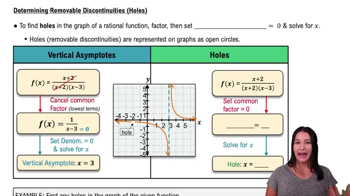Table of contents
- 0. Review of Algebra4h 16m
- 1. Equations & Inequalities3h 18m
- 2. Graphs of Equations43m
- 3. Functions2h 17m
- 4. Polynomial Functions1h 44m
- 5. Rational Functions1h 23m
- 6. Exponential & Logarithmic Functions2h 28m
- 7. Systems of Equations & Matrices4h 6m
- 8. Conic Sections2h 23m
- 9. Sequences, Series, & Induction1h 19m
- 10. Combinatorics & Probability1h 45m
5. Rational Functions
Asymptotes
Problem 75a
Textbook Question
In Exercises 57–80, follow the seven steps to graph each rational function. f(x)=x^4/(x^2+2)
 Verified step by step guidance
Verified step by step guidance1
Identify the domain of the function. Since the denominator cannot be zero, set \(x^2 + 2 = 0\) and solve for \(x\). However, \(x^2 + 2\) is never zero for real numbers, so the domain is all real numbers.
Determine the vertical asymptotes. Since the denominator \(x^2 + 2\) is never zero, there are no vertical asymptotes.
Find the horizontal asymptote by comparing the degrees of the numerator and the denominator. The degree of the numerator is 4, and the degree of the denominator is 2. Since the degree of the numerator is greater, there is no horizontal asymptote.
Check for oblique (slant) asymptotes. Since the degree of the numerator is exactly two more than the degree of the denominator, perform polynomial long division of \(x^4\) by \(x^2 + 2\) to find the slant asymptote.
Analyze the behavior of the function as \(x\) approaches infinity and negative infinity, and plot key points to sketch the graph. Consider the end behavior and any intercepts or symmetry to guide the sketch.
Recommended similar problem, with video answer:
 Verified Solution
Verified SolutionThis video solution was recommended by our tutors as helpful for the problem above
Video duration:
14mPlay a video:
Was this helpful?
Key Concepts
Here are the essential concepts you must grasp in order to answer the question correctly.
Rational Functions
A rational function is a function that can be expressed as the ratio of two polynomials. In the given function f(x) = x^4/(x^2 + 2), the numerator is a polynomial of degree 4, and the denominator is a polynomial of degree 2. Understanding the behavior of rational functions, including their asymptotes and intercepts, is crucial for graphing them accurately.
Recommended video:

Intro to Rational Functions
Graphing Steps
The seven steps to graph a rational function typically include identifying the domain, finding intercepts, determining asymptotes, analyzing end behavior, and plotting points. Each step builds on the previous one to create a comprehensive picture of the function's behavior. Following these steps systematically helps ensure an accurate graph.
Recommended video:

Transformations of Exponential Graphs
Asymptotes
Asymptotes are lines that a graph approaches but never touches. For rational functions, vertical asymptotes occur where the denominator is zero (and the numerator is not), while horizontal asymptotes describe the behavior of the function as x approaches infinity. Identifying these asymptotes is essential for understanding the overall shape and limits of the graph.
Recommended video:

Introduction to Asymptotes

 6:24m
6:24mWatch next
Master Introduction to Asymptotes with a bite sized video explanation from Callie
Start learningRelated Videos
Related Practice








